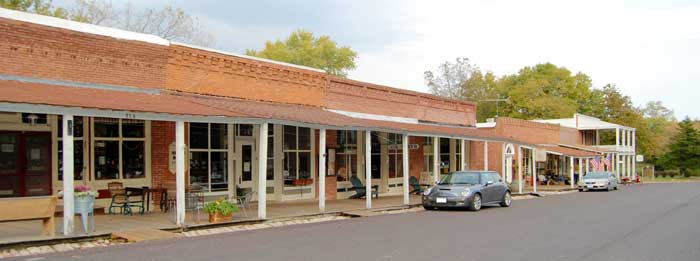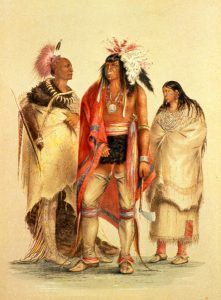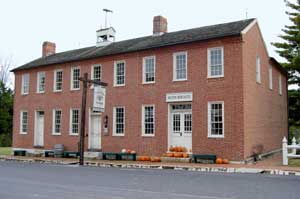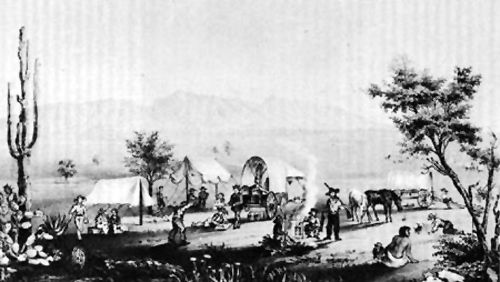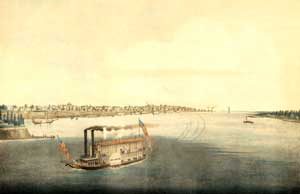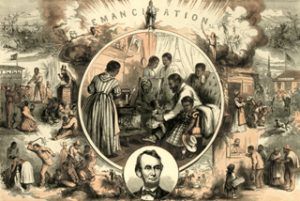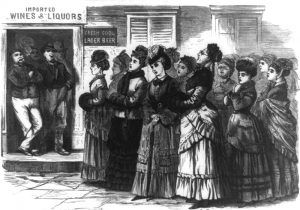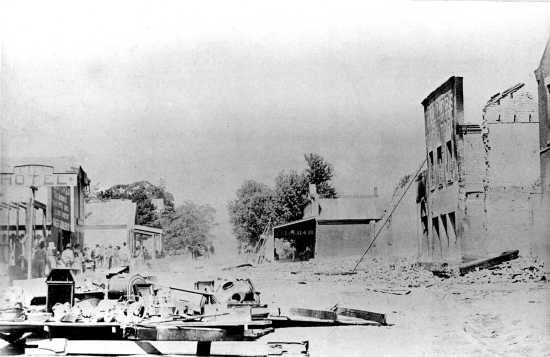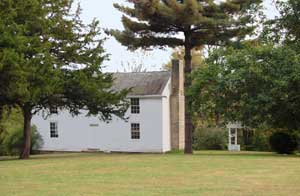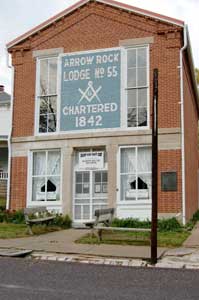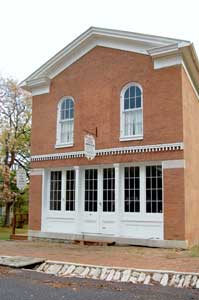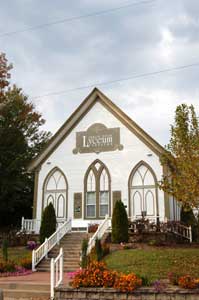Arrow Rock, Missouri, a historic village on the Santa Fe Trail, commemorates the beginning of the Santa Fe trade.
Today, this small town on the Missouri River in Saline County is designated a National Historic District for its significance during Westward Expansion, the Lewis and Clark National Historic Trail, and the Santa Fe Trail.
The place was first called Arrow Rock due to a prominent flint-bearing bluff on the Missouri River and first appeared on a French map in 1732 as “Pierre a Fleche,” meaning “Rock of Arrows.”
The two dominant Native American tribes in the area encountered by French traders early in the 18th century were the Missouria and the Osage.
For the next 150 years, this bluff would be a landmark to explorers and travelers. When Lewis and Clark passed by on June 9, 1804, they noted the bluff, and in 1808 when William Clark passed through the area again on his way to construct Fort Osage, he noted a “Big Arrow Rock” and a “Little Arrow Rock” just upstream from it. He also declared the area would “make a handsome spot for a town.”
“Arrow Rock is so called from its having been formerly resorted to by neighboring Indians for the stone used to point their arrows.”
— Edwin James, 1819 Yellowstone Expedition
Years later, the Missouri River shifted away from the channel that early explorers had traveled. The land is now a federal wildlife refuge, and the bluff can no longer be seen from the river.

Boonslick, Missouri
During the first half of the 19th century, this region of central Missouri was called “Boonslick Country,” named for the Boone’s salt lick about four miles east of Arrow Rock in Howard County. The term “lick” is derived from wildlife licking salt from the ground around the briny springs. Nathan and Daniel Morgan Boone, sons of famed frontiersman Daniel Boone, manufactured salt here from 1805-1812, shipping it to St. Louis. Their partners and co-operators, James and Jesse Morrison, continued the salt business until 1833. Salt boiling continued intermittently until the 1860s. The site of this early frontier industry is now the Boone’s Lick State Historic Site.
More white settlers arrived in 1810 and established small settlements several miles north and south of the Arrow Rock bluff and in the river bottoms on the opposite side of the Missouri River. During the War of 1812, these settlers built small defensive forts as protection from Ioway and Sac and Fox Indians allied to Great Britain. When Fort Osage closed in 1813, the fort’s leading trader, George C. Sibley, moved his operation to the Arrow Rock bluff during the winter of 1813 -1814 to carry on trade with the Osage Indians. This helped maintain their loyalty to the United States during the war.
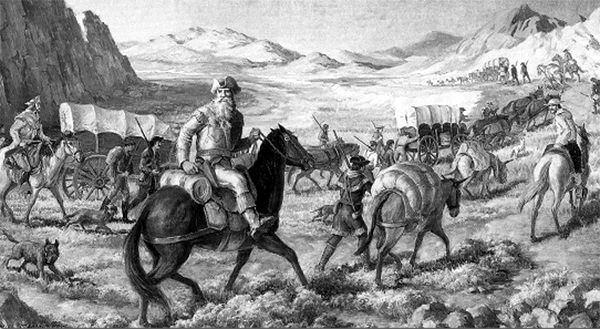
William Becknell blazes the Santa Fe Trail.
The Missouri River crossing at Arrow Rock figured prominently in the early trail-breaking expeditions that opened the West. By 1815, a ferry was established at Arrow Rock, and eastbound settlers poured into the area, crossing the Missouri River on the ferry. In 1819, a road was laid from the ferry to Cooper’s Fort in New Franklin, Missouri. This road was later incorporated into the post road from Arrow Rock to Fort Osage and became the great thoroughfare of early traders. Both pioneering expeditions to Santa Fe, New Mexico, led by William Becknell in 1821 and 1822, were organized at Arrow Rock.
In 1819, Dr. John Sappington moved to Arrow Rock. He established two stores that sold goods throughout his time in the community, loaned money, processed salt, and milled lumber. However, his claim to fame was achieved when he began pursuing more experimental medical practices, leading to his eventual creation of “a quinine pill to treat malaria in the Missouri area,” a prominent disease at the time.
The town was officially founded in June 1829 and was originally called “Philadelphia.” However, in 1833 the state legislature changed the name because the locale was better known as ‘Arrow Rock.’ Joseph Huston, one of the town commissioners, built a two-story brick building in 1834. Due to Arrow Rock’s location on the Missouri River and along the Santa Fe Trail, travelers undoubtedly asked Huston for overnight accommodations. He then began building frame or log additions to the brick building and, by 1840, was widely known as a hotel keeper. The J. Huston Tavern also housed a store, a ballroom for dances, and a meeting hall. Today, the J. Huston Tavern houses the oldest continuously operating restaurant west of the Mississippi River. The Missouri Division of State Parks operates it with the Friends of Arrow Rock, Inc.
In the Arrow Rock area, Settlers were predominantly migrants from Virginia, Kentucky, and Tennessee who brought slaves and Southern culture with them. The town developed as a thriving river port, exporting tobacco and hemp from plantations in the region. Wheat, corn, beef, pork, and mules were shipped from Arrow Rock to supply the Mississippi Delta’s cotton districts. This agricultural production depended upon slave labor as cotton production did in the South. Other slaves worked as household or domestic servants or laborers at the docks and business warehouses. Much of the town’s infrastructure, such as the massive stone gutters lining Main Street, was built by enslaved African-Americans.
In 1849 and 1850, covered wagons of emigrants headed to California “were hardly ever out of sight at Arrow Rock.”
In the 1850s, while the area fields were not producing cotton, the plantation mentality in Missouri was the same as it was in the South. Arrow Rock’s economic system was built on slavery, supporting it, so as the Civil War loomed, the area citizens, like many others in Missouri, supported the Confederacy.
During this time, there was such hostility to the idea of freeing slaves that several lynchings took place in Arrow Rock, Marshall, and other surrounding communities in 1859. Those who advocated slavery were often loud and were sometimes involved in mob violence. Sometimes, snipers stood atop the bluffs shooting at the riverboats going up and down the river.
Arrow Rock’s population peaked at 1,000 by 1860, and many Arrow Rock residents continued to be involved in the Santa Fe trade as late as the beginning of the Civil War.
When the war began, so many area residents supported the South that the region later became identified as “Little Dixie.” Shooting at riverboats continued and became such a nuisance that federal forces sent a gunboat up the river and shelled the town. Everybody fled outside the city limits, and after the First Battle of Lexington, when the town had been captured by Major General Sterling Price and the state guard forces, some thought to move there because it was a more secure location.
Though no major battles were fought in the area, guerrilla raids and murders disrupted agricultural production and river commerce. Union militia eventually enforced martial law on the town during most of the war.
In the summer of 1864, a band of guerrillas rode into town determined to exterminate the First Missouri State Militia, which had taken housing in a brick building on Main Street. As a precaution, Lieutenant J.M. Woodruff placed the unit’s flag outside the Wood and Huston building. The guerrillas set the decoy building on fire, attempting to rouse their enemies out of it. However, the Wood and Huston building burned while the diversion protected the troops.
In August 1864, sparks from steamboat Isabella’s stacks set fire to the riverfront of Arrow Rock, and the flames destroyed four warehouses.
Following emancipation in 1865, Arrow Rock’s African-American population grew as former plantation slaves moved into town. There was some hope that Arrow Rock would return to its glory days. Even in 1868, it was still considered the busiest riverport between St. Louis and Kansas City, and there were 14 stores and over 100 homes inside city limits. The town also supported a woolen factory, flour mills, lumber yards, sawmills, waterfront warehouses, two schools, four churches, a billiard hall, a solvent bank, and an art gallery. Service people included four doctors and a dentist.
However, the population began to decline as railroads supplanted steamboat commerce.
In 1872, a terrible fire began in the business district. It destroyed the two and three-story buildings, prompting the Saline County Progress newspaper to call it “the most destructive fire ever known in central Missouri.” The fire originated in John Gilpin’s saloon’s upper room, located on the corner of Fourth and Main Streets. Immediately, rumors began to flare, stating that the blaze resulted from arson, and three men were lynched. Various tales say that one or all of the hanged men were black.
The fire led to a temperance movement in town, and The Board of Trustees increased the license fees of “dram shops” from $75 to $400 annually, resulting in their closure.
During the next decades, the growth of urban areas such as Kansas City, St. Louis, and Chicago began drawing away residents with the promise of better jobs. By 1880, the town’s population had dropped 304, 51% of whom were African-American. Owing to the segregation of the time, they developed their own churches, schools, and social institutions.
By the turn of the 20th century, the town’s population was 358. In the next decades, the population of Arrow Rock continued to drop at every census.
On July 11, 1901, a lamp ignited a fire in a two-story brick building and robbed the town of over a dozen businesses, offices, and residences. Only the first floors of the boardwalk stores were rebuilt after that.
A newspaper article, most likely from the Weekly Democrat-News, stated, “The citizens worked heroically battling the flames. There was not much water at hand.”
The ferry across the Missouri River continued to operate until 1927. It closed because bridges had been built at Boonville and Glasgow.
But, the preservation of the small town began at an early date.
Arrow Rock’s connection with the Santa Fe Trail led to national recognition by the Old Trails Society of the Daughters of the American Revolution (DAR) in 1912. As DAR’s interest in the community grew, they persuaded the Missouri legislature to purchase and preserve the old J. Huston Tavern in 1923 and acreage around the Tavern was purchased as a state park. This marked the beginning of historic preservation in Missouri. Over time, the park grew to 169 acres, about a third of which lies within the town’s boundaries. The Friends of Arrow Rock, Inc. was formed in 1959 to preserve historic structures outside the state park boundary. In 1963, the entire village was designated a National Historic Landmark by the National Park Service and is known in this context as the Arrow Rock Historic District. In addition, many structures within the village are individually listed on the National Register of Historic Places. In 1976, the site was changed from a state park to a state historic site to reflect its cultural mission better.
Though Arrow Rock supports only about 50 residents today, it remains a wonderful Missouri destination for its many historic buildings and 19th-century history. To welcome visitors, the town has numerous bed and breakfast establishments, shops, restaurants, and a modern campground nearby is maintained by the Missouri Division of State Parks.
Arrow Rock Historic Sites:
Arrow Rock Bluff – The rock cliff of Arrow Rock, the remains of the old Ferry Road, and the Santa Fe Spring used by those who rendezvoused here in the early days of the Santa Fe Trail are preserved in Arrow Rock State Park. For generations, Arrow Rock Bluff was a significant landmark on the Missouri River for Native Americans, explorers, and early westward travelers. This flint-bearing, high limestone bluff first appeared on a 1732 French map as “Pierre a fleche,” literally translated as “rock of arrows.” Archaeological evidence shows that for nearly 12,000 years, indigenous cultures used the Arrow Rock Bluff as a manufacturing site for flint tools and weapons.
Arrow Rock Academy Boarding House – This frame structure, built about 1843, housed a succession of girls’ schools until long after the Civil War. Today, it is the residence of the Park superintendent.
Arrow Rock Baptist Church/Lyceum Theater – Located near the Bingham House, this building is now used as a summer repertory theater called the Arrow Rock Lyceum. The theater opens on July 4th for an eight-week season annually.
Arrow Rock Town Spring – This spring is located in the valley below the town, near the former road leading from the river landing into the town.
Arrow Rock Jail – Built in 1871, this small stone building with a wrought iron door was built in a wing of the George Caleb Bingham House. Bingham sold the property in 1845.
Arrow Rock Lodge No. 55 – This lodge was formed in 1842. In 1868 they constructed this brick building with their hall on the second floor, and the first floor was rented for commercial purposes. The first floor is presently used by the Arrow Rock Craft Club, which sells only hand-made articles, homemade jams, jellies, pickles, cakes, pies, and bread.
George Caleb Bingham House – George Caleb Bingham would grow into manhood in Arrow Rock. Newly married to his first wife, Sarah Hutchinson, he bought a lot and built his first home in 1837. The house still stands at the High and First Streets corner and was designated a National Historic Landmark in 1965. Bingham would become one of the greatest American painters of the 19th century. Although Bingham would travel extensively in the United States and Europe during the following decades, he called Arrow Rock home.
Dr. Charles M. Bradford House – The original frame portion was built between 1831-1841 by William G. Miller. Additions were made to the house by Dr. Bradford following his purchase of the property in 1841. Dr. Bradford, a graduate of the University of Pennsylvania, came to Arrow Rock in 1840, where he married Miss Lavinia Pearson, a granddaughter of Dr. John Sappington. The building is privately owned.
Cumberland Presbyterian Church – Built in 1857, this building is now owned by the congregation of Zion Evangelical and Reformed Church of Arrow Rock.
The Dr. Matthew Walton Hall House – A one-and-a-half-story brick house constructed about 1845, was owned by one of the pioneer physicians of Saline County. It is now the headquarters for the Missouri Society, Daughters of the American Revolution.
I.O.O.F. Hall and Print Shop Museum – Built in 1868, with lodge rooms on the second floor. The first floor was originally occupied by a newspaper office, where the Saline County Herald was published. Today, it houses the collections of the Missouri Press Association.
Old Court House This two-room log structure, with woodwork and clapboarding dating from about 1830, served as the temporary Court House
of Saline County from 1839-40.
Huston Tavern – Built in 1834 this Federal-style brick tavern was built in 1834 by Judge Joseph Huston, one of the original town commissioners of Arrow Rock. Originally called the City Hotel, Huston added a store in about 1840 with a second-floor ballroom. Visitors may view the restored summer kitchen and upstairs ballroom and bedrooms. The Tavern continues to serve country-style meals.
Dr. William Price House – Dr. Price, a native of Maryland, began the practice of medicine in Arrow Rock on September 24, 1835. After he married Mary Ellen Sappington, a daughter of Dr. John Sappington, he built this handsome brick house in about 1838. Part of the early and perhaps original wooden fence of ornamental design remains along the backyard. It is now a private residence.
©Kathy Alexander/Legends of America, May 2023.
Also See:
Early Traders on the Santa Fe Trail
Santa Fe Trail – Highway to the Southwest
Sources:
Marshall Democrat News
Missouri Secretary of State
National Register Nomination
Village of Arrow Rock, Missouri
Washington University
Wikipedia

